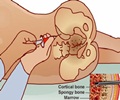
During the last decade, some researchers have claimed that primordial follicles in adult mouse ovaries turn over and that females use adult germ-line stem cells to constantly resupply the follicle pool and sustain ovulation. These claims were based on subjective observations of ovarian tissue and on the behavior of extremely rare ovarian cells following extensive growth in tissue culture, a procedure that is capable of "reprogramming" cells.
Lei and Spradling used a technique that allows individual cells and their progeny within a living animal to be followed over time by marking the cells with a new gene. This general approach, known as lineage-tracing, has been a mainstay of classical developmental biology research and has greatly clarified knowledge of tissue stem cells during the last decade.
Their research showed that primordial follicles are highly stable, and that germ-line stem cell activity cannot be detected, even in response to the death of half the existing follicles. The research placed a stringent upper limit on the stem cell activity that could exist in the mouse ovary and escape detection--one stem cell division every two weeks, which is an insignificant level.
What about the rare stem-like cells generated in cultures of ovarian cells? According to Spradling, these cells "likely arise by dedifferentiation in culture," and "the same safety and reliability concerns would apply as to any laboratory-generated cell type that lacks a normal counterpart" in the body.
Source-Eurekalert











